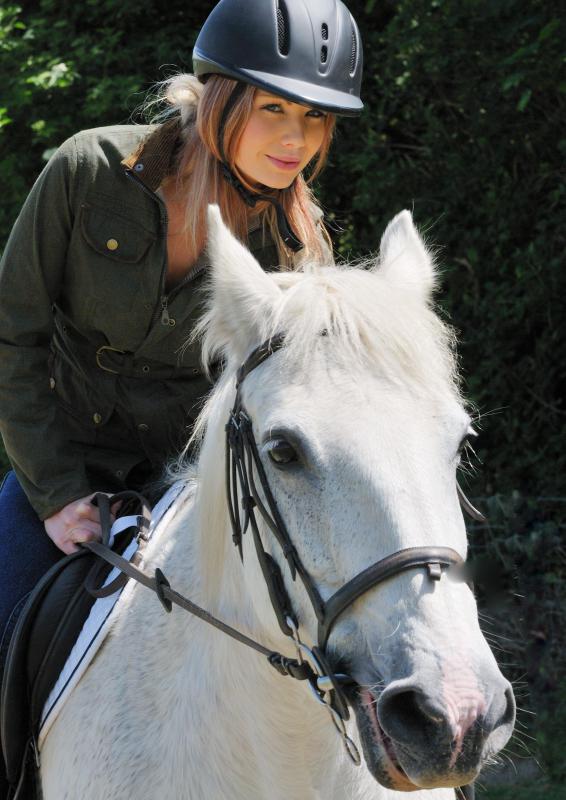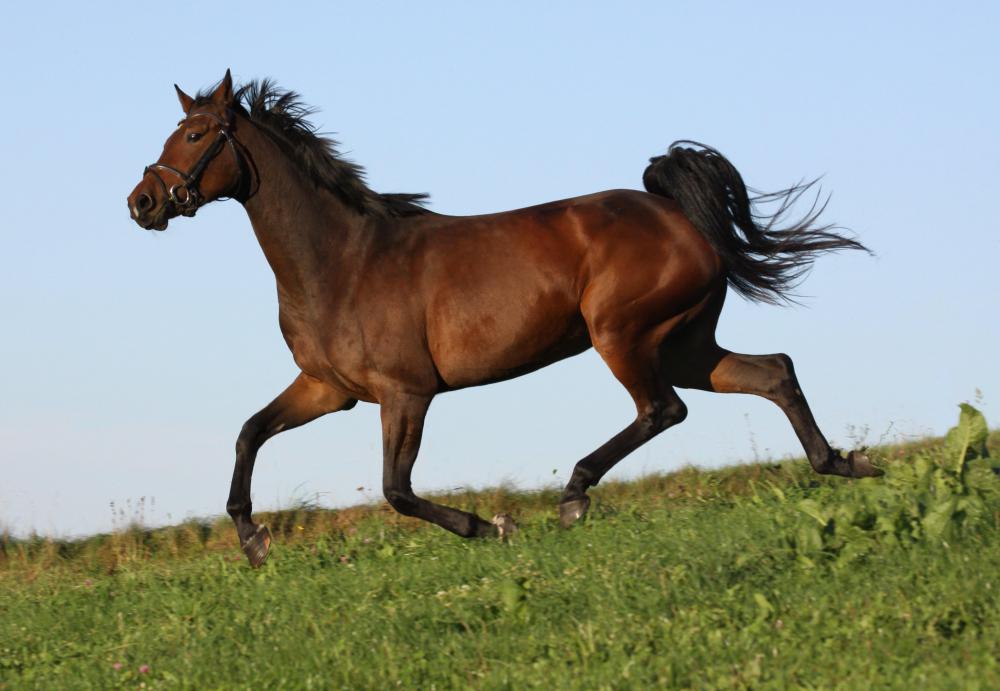At AllThingsNature, we're committed to delivering accurate, trustworthy information. Our expert-authored content is rigorously fact-checked and sourced from credible authorities. Discover how we uphold the highest standards in providing you with reliable knowledge.
What is Cantering?
Cantering is a three beat horse gait which falls between the trot and the gallop in terms of speed. This gait is very smooth, especially on a well-trained horse, and developing skills at the canter is important for both horses and riders. When the canter is accelerated, it turns into the gallop, a four beat and extremely fast gait.
Describing a horse's movements at the canter is a bit complicated; basically, the gait starts with one rear leg on the ground, and the three other legs in the air. The next step involves setting the opposite foreleg and the other hind leg on the ground, and then the original leg is lifted while the foreleg on the same side is brought to the ground. Then, all the legs are lifted at once to prepare for the next cycle, in what is known as the “suspension phase.” While riders had long suspected that there was a point in the canter where no feet were touching the ground, it was Edward Muybridge who was able to prove it in the 1800s, with the assistance of photography.

You may have heard riders referencing “leads” when discussing cantering. The lead is defined by the leg which leaves the ground last before the suspension phase, and it makes a big difference to the horse's appearance and balance. Horses need to be able to change leads easily to compensate for changes in terrain, and in dressage, horses are sometimes asked for flying lead changes, in which the lead is changed in mid-canter.

As with other horse gaits, there are different types of cantering. All horses can naturally demonstrate the working canter, which is a natural form of the gait. In a collected canter, the horse is asked for more control, creating a compact gait with smaller strides which showcases control and power in the hindquarters. Horses can also be taught to do the extended canter, a gait which is very close to a gallop. Western horses often learn to lope; loping is a slower version of cantering well-suited to a long workday on the range.

Many riders like to sit while cantering, because it offers them greater control. While seated, a rider can shorten or lengthen the stride, and keep the horse stable. Some riders use a half-seat, in which they are partially raised from the saddle; this is common in jumping. Other riders use a version of posting, in which they move from a seated to a standing position; this is sometimes seen in polo and buzkashi.
Frequently Asked Questions
What is cantering in horse riding?

Cantering is a controlled three-beat gait that is faster than a trot but slower than a gallop. The horse moves its legs in a specific sequence that gives the ride a rocking or rolling motion. It's often used in English riding disciplines and is considered a moderate-speed gait that can be sustained over longer distances compared to the gallop.
How does cantering differ from trotting and galloping?
Cantering is distinct from trotting and galloping based on rhythm and speed. A trot is a two-beat gait where diagonal pairs of legs move together, while a gallop is a four-beat gait and the fastest a horse can move. Cantering's three-beat sequence creates a smoother ride and falls between the trot's bounce and the gallop's rush.
Is cantering safe for beginner riders?
Cantering can be safe for beginners under proper supervision and with a well-trained horse. It's important for the rider to have mastered basic riding skills, such as maintaining balance and controlling the horse at slower gaits before progressing to cantering. Safety also depends on wearing appropriate gear and learning how to execute the canter correctly.
What are the benefits of cantering for both horse and rider?
Cantering offers numerous benefits, including improved balance and coordination for the rider, and better muscle development and cardiovascular health for the horse. It also enhances the bond between horse and rider, as it requires a higher level of communication and trust. Riders often find cantering exhilarating, which can boost confidence and riding skills.
How do you cue a horse to canter?
To cue a horse to canter, the rider typically applies pressure with the outside leg slightly behind the girth and the inside leg at the girth, while gently pushing with the seat and maintaining a light contact with the reins. It's important to cue smoothly to maintain the horse's rhythm and balance as it transitions into the canter.
Can all horses canter, and do they all canter the same way?
All healthy horses have the ability to canter, but the way they perform the gait can vary widely based on breed, training, and individual temperament. Some breeds have a naturally smoother canter, while others may require more training to achieve a comfortable canter. Additionally, some horses may have a more energetic or powerful canter than others.
AS FEATURED ON:
AS FEATURED ON:














Discuss this Article
Post your comments